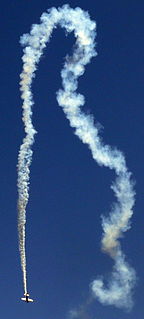
Aerobatics is the practice of flying maneuvers involving aircraft attitudes that are not used in conventional passenger-carrying flights. The term is a blend of "aerial" and "acrobatics". Aerobatics are performed in aeroplanes and gliders for training, recreation, entertainment, and sport. Additionally, some helicopters, such as the MBB Bo 105, are capable of limited aerobatic manoeuvres. An example of a fully aerobatic helicopter, capable of performing loops and rolls, is the Westland Lynx.
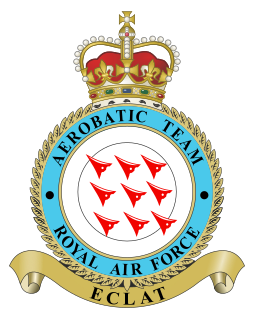
The Red Arrows, officially known as the Royal Air Force Aerobatic Team, is the aerobatics display team of the Royal Air Force based at RAF Scampton. The team was formed in late 1964 as an all-RAF team, replacing a number of unofficial teams that had been sponsored by RAF commands.

The Roulettes are the Royal Australian Air Force's formation aerobatic display team. They provide about 150 flying displays a year, in Australia and in friendly countries around the Southeast Asian region. The Roulettes form part of the RAAF Central Flying School (CFS) at RAAF Base East Sale, Victoria.
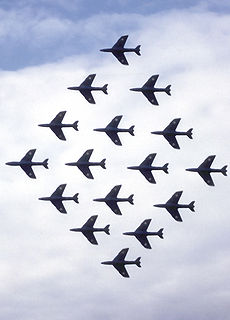
The Black Arrows, one of the predecessors to the current Royal Air Force Aerobatic Team the Red Arrows, were an aerobatic demonstration team formed in 1956 by Squadron Leader Roger L.Topp, then Commanding Officer 111 Squadron ("treble-one"). One of the many memorable feats accomplished by the Black Arrows was the execution of a world record loop of 22 Hawker Hunters in formation at the Society of British Aircraft Constructors' show at Farnborough in 1958. This was a world record for the greatest number of aircraft looped in formation, and remains unbroken to this day. After the loop the Black Arrows performed the world's first 16 aircraft barrel roll. Roger Topp handed over the lead of the Black Arrows to Squadron Leader Peter Latham in late 1958. Latham expanded the size of the team to nine aircraft from the original five and led the Squadron for two years.

The Snowbirds, officially known as 431 Air Demonstration Squadron, are the military aerobatics flight demonstration team of the Royal Canadian Air Force. The team is based at 15 Wing Moose Jaw near Moose Jaw, Saskatchewan. The Snowbirds' official purpose is to "demonstrate the skill, professionalism, and teamwork of Canadian Forces personnel". The team also provides a public relations and recruiting role, and serves as an aerial ambassador for the Canadian Armed Forces. The Snowbirds are the first Canadian air demonstration team to be designated as a squadron.
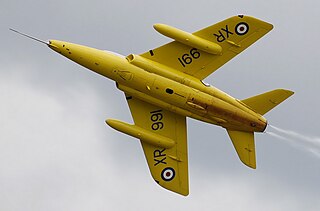
The Yellowjacks were a Royal Air Force aerobatic display team which flew Folland Gnat trainers painted yellow. The team was formed informally in the summer of 1963 by a group of flying instructors, led by Flight Lieutenant Lee Jones, at No 4 Flying Training School at RAF Valley. The two-seat Gnat T.1 had been in service at Valley only since February of that year, when the first 20 student pilots, selected after being awarded their "wings", from the recently graduated No 82 Entry of the RAF College Cranwell, had started their advanced training on the Gnat. Instructors and student pilots loved this aircraft, because of its small size and its sensitive handling and high manoevrability.

Surya Kiran is an aerobatics demonstration team of the Indian Air Force. The Surya Kiran Aerobatic Team (SKAT) was formed in 1996 and are a part of the 52nd Squadron of the IAF. The team has since performed numerous demonstrations usually with nine aircraft. The squadron was composed of the HAL HJT-16 Kiran Mk.2 military trainer aircraft till 2011 and were based at the Bidar Air Force Station in Karnataka. The team was suspended in February 2011 and was re-established with Hawk Mk-132 aircraft in 2017.

The BAC Jet Provost is a British jet trainer aircraft that was in use with the Royal Air Force (RAF) from 1955 to 1993. It was originally developed by Hunting Percival from the earlier piston engine-powered Percival Provost basic trainer, and later produced by the British Aircraft Corporation (BAC). In addition to the multiple RAF orders, the Jet Provost, sometimes with light armament, was exported to many air forces worldwide. The design was also further developed into a more heavily armed ground attack variant under the name BAC Strikemaster.

Blue Impulse is the aerobatic demonstration team of the Japan Air Self-Defense Force (JASDF). The team was founded in 1960 as a team of six F-86 Sabres. They changed mounts to the Mitsubishi T-2 in 1980 and then to the Kawasaki T-4 in 1995. They are based at Matsushima Air Base, which was heavily damaged by the 2011 Tōhoku earthquake and tsunami.
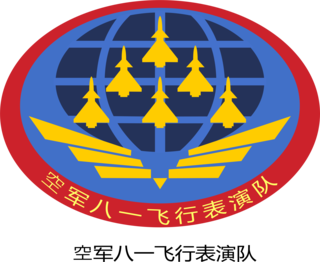
The August 1st or Ba Yi Aerobatics Team is the aerobatic demonstration team of the People's Liberation Army Air Force (PLAAF). It was founded in 1962 and named after the date of founding of the People's Liberation Army (PLA), August 1, 1927.

Sagar Pawan is the aerobatic demonstration team of the Indian Navy's Aviation Arm. It is one of the only two naval aerobatic teams in the world, the other being the Blue Angels of the US Navy.

Raynham George Hanna, was a New Zealand-born fighter pilot who emigrated to England to join the Royal Air Force (RAF). During his RAF career he was a founding member of its Red Arrows aerobatics display team. He also founded The Old Flying Machine Company, which commercially flies Second World War vintage fighter aircraft at air displays around the world, and for television and cinematic productions. He was a Spitfire display pilot in the latter half of the 20th century, noted for his daring and disciplined aerobatic stunt flying.

Sherdils is the aerobatics display team of the Pakistan Air Force (PAF) & Royal Pakistan Air Scouts (RPAS). The Sherdils are based at the Pakistan Air Force Academy, Risalpur, Pakistan and consist of nine Karakoram K-8P aircraft.
The Leteće zvezde was the official aerobatic flight display team of the Yugoslav Air Force.

The Black Knights is the official aerobatics team of the Republic of Singapore Air Force (RSAF) featuring six F-16C Fighting Falcons in formation flight. The Black Knights' emblem is sported on the red vertical tail of each of the team's aircraft and the team's name is emblazoned on both sides of the aircraft which are painted in red and white – the national colours of Singapore.

The Saudi Falcons are a BAE Hawk-equipped Royal Saudi Air Force aerobatic team.
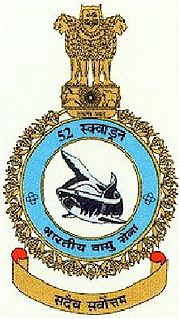
No. 52 Squadron is an aerobatic squadron of the Indian Air Force. It was established in January 1986. It is presently based at Bidar Air Force Station. It is popularly known as the Surya Kiran Aerobatic Team (SKAT). SKAT performs across the country, and has performed in China, the UK, Germany, Laos and Sri Lanka. The Surya Kirans were among the top three nine-aircraft aerobatics teams in the world, along with the British Red Arrows and the Canadian Snowbirds. The Squadron motto is "Sadaiv Sarvottam", which translates as "Always the Best". For its consistent performance since 1996, the Suryakiran was awarded Chief of the Air Staff's Unit Citation on 8 October 2004. It is the first unit in the IAF to receive this award.
No. 6 Flying Training School RAF is a Flying Training School (FTS) within No. 22 (Training) Group of the Royal Air Force that delivers flying training to University Air Squadrons and Air Experience Flights.

No. 4 Flying Training School is a Royal Air Force military flying training school, which manages Advanced Fast Jet Training (AFJT) from its base at RAF Valley in Anglesey, Wales. Its role is to provide fast jet aircrew to the Operational Conversion Units for the RAF's jet attack aircraft, the Eurofighter Typhoon and the Lockheed Martin F-35 Lightning II.

















